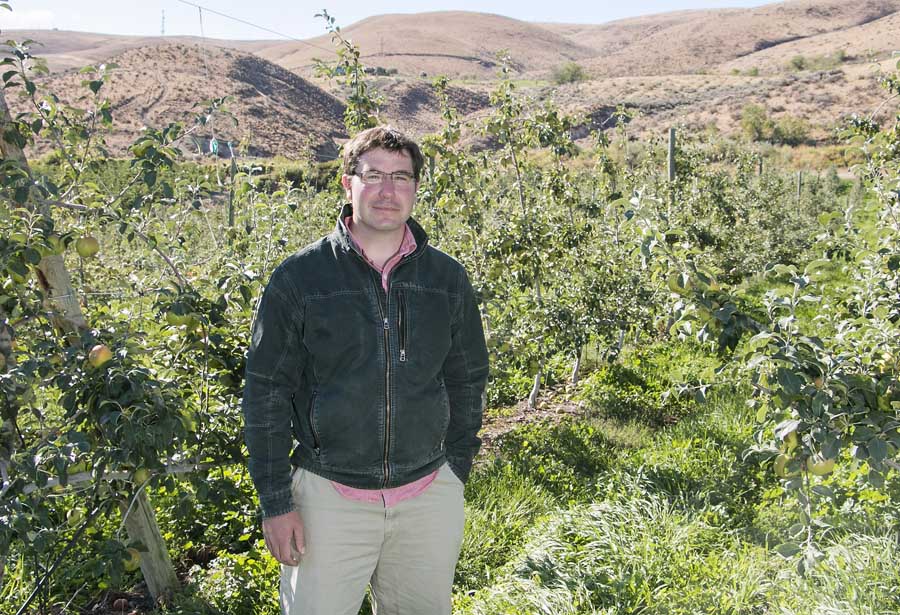
Marcus Robert at Tieton Cider Works’ cider orchard in Yakima, Washington in 2014. (TJ Mullinax/Good Fruit Grower file photo)
Why should anyone bother growing cider fruit?
Let’s start with what cider fruit is.
There are more than 7,000 varieties of apples in the world and most have the potential to make some quality of cider.
In the world of cider, apples are divided into four distinct categories: Sweet, Sharp, Bittersweet and Bittersharp. The differences in the categories are based on acid and tannin levels.
Sweets could be apples you can find every day in the supermarket: Galas, Honeycrisp and Red Delicious, for example. These are apples that have low amounts of acid, which make them taste sweet.
Good examples of sharps would be Granny Smith and Newtown Pippins, very high acid apples.
Take those two categories, Sharps and Sweets, and add tannins and you have Bittersweet and Bittersharp apples.
Although there are some heirloom varieties of apples like Golden Russet and Ashmead Kernel from which people make cider, these Bittersweet and Bittersharp apples are really what we are talking about when we say “cider fruit.”
Cider fruit has been grown for centuries in different parts of the world. In these cultures, ciders made from bittersweets and bittersharps are commonplace or even expected. Here we can make a correlation to why someone would grow table grapes versus wine grapes.
One has been bred to produce fruit that has qualities suitable for fresh eating, while the other grape has been bred to produce qualities that can translate into great wines when placed in the right hands. Cider fruit can be looked at the same way we look at wine grapes.
They produce qualities that dessert apples (Gala, Honeycrisp, etc.) will typically not provide. These include tannins, aromas and other characteristics that are important in producing complex and interesting ciders.
Making complex and interesting cider will translate into greater market demand, which, in turn, will create more opportunity for the grower.
When researching these apples, you will find unfamiliar names that are a great departure from the highly marketed dessert fruit we see every day.
Some of the more available varieties include Yarlington Mill, Dabinette and Kingston Black.
Back to the initial question. Why consider cider fruit?
Currently there is very little cider fruit being grown in the U.S. when compared to demand.
The U.S. cider industry has taken off since 2011 and is expected to see double-digit growth over the next five years.
With the relative shortage of cider fruit in the industry, cider makers are left utilizing dessert fruit, concentrates or imports to supplement their production.
There has been more and more competition to find that fruit as more cideries are emerging. This is why, in 2008, apple growers Craig and Sharon Campbell started planting cider fruit on Harmony Orchards near Yakima, Washington. At that time, cider fruit was even more scarce.
The Campbells viewed it as a necessity to make the investment and to supply Tieton Cider Works with the appropriate fruit to make their quality cider.
Although most cider fruit can produce lower yields and are typically more biennial than commercially grown dessert fruit, the price to the grower has been good. Returns have been in the range of $800 to $1,200 per ton. Moreover, cider fruit is not scrutinized under costly third-party, grower-practice audits.
Cider fruit is also not subject to packing charges and other processing fees to get fruit to market. This means that the whole of the crop is returning revenue to the grower.
We’re lucky to have industry support. There has been some ongoing research in cider fruit developed by Washington State University with sponsors from organizations like the Northwest Cider Association (NWCA). NWCA was started by a handful of cidermakers in Oregon and Washington in 2010.
It now has 75 cider maker members in Oregon, Washington, Idaho, Montana and British Columbia, with an overall membership of 300.
The goal of NWCA is to share knowledge and promote regionally crafted artisan ciders. Tieton Cider Works was a founding member of NWCA, as we saw a need to pool our efforts in support of a burgeoning industry.
Many of the NWCA members are also growers and as a community are more than willing to share information about growing cider fruit and producing good cider.
If you would like to know more about the national industry, I strongly suggest attending some of the courses at this year’s CiderCon in Chicago in February 2017.
This event, which began in 2011, has grown from 30 attendees to more than 1,000 in 2016. The conference offers many classes and roundtable discussions in orcharding, cider making and general industry knowledge. Come see what all the bother is about. •
– by Marcus Robert, a fourth-generation Yakima Valley farmer and is Tieton Cider Works’ operations manager.






Leave A Comment